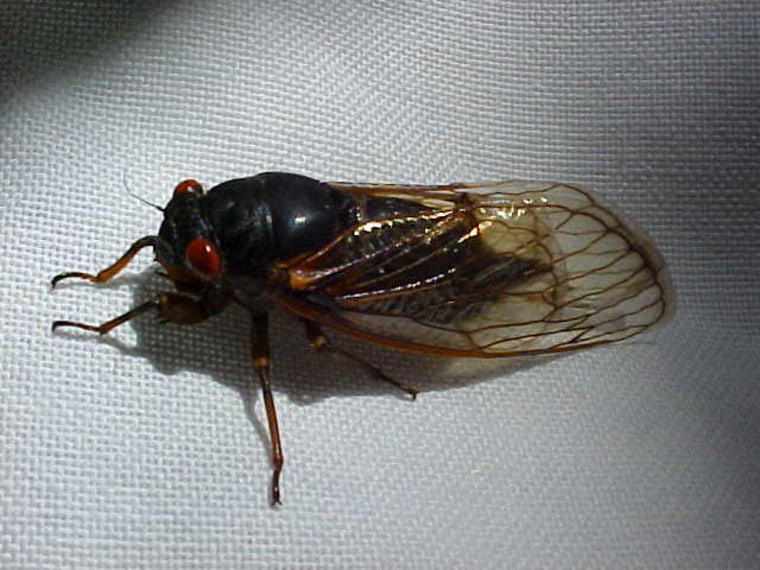The last cicada from this year's "Swarmageddon" died of old age on Friday, in a refrigerator in Pennsylvania. Like billions of her red-eyed broodmates on the East Coast, the dearly departed bug was 17 years old.
Bug collector Bob Jacobson kept the female cicada alive for weeks longer than usual by chilling down her metabolism in the fridge — but no bug lives forever. On Friday, the last of 14 insects that Jacobson captured in June finally went still.
"It's probably the last one of its brood," he told NBC News. "I guess this makes it officially over for the year."
In the world beyond Jacobson's icebox, the mass die-off of Brood II periodical cicadas hit its peak weeks ago. To be sure, cicadas are still being seen and heard — but those bugs are the "dog-day" cicadas that hatch out every summer, said John Cooley, an entomologist at the University of Connecticut.
"It's July," Cooley said. "This is their time of year."
Those annual cicadas don't have the red eyes and 90-decibel buzz that the periodical cicadas have. And they don't follow the peculiar life cycle that characterized Brood II — a cycle that starts with 17 years of crawling underground and sucking on plant roots, followed by a weeks-long fling of flying, singing and mating. It's that massive emergence of insects that made such an impression on bug-watchers from the Carolinas to upstate New York.
Or did it?
Sizing up Swarmageddon
As the April-to-June phenomenon passed its peak, many wondered whether Swarmageddon was oversold. NBC Philadelphia's story, for example, was headlined "The Cicada Invasion That Wasn't." Comic actress Rachel Dratch lodged her complaint in a Twitter tweet: "It just dawned on me that I didn't see one damn cicada. #RipOff."
Cooley said this year's outbreak was actually pretty much in line with the experts' expectations. "The Swarmageddon was a product of hype, and that was generated by people who had inaccurate maps," he insisted. Cicada outbreaks are notoriously spotty: A chorus of the insects may have buzzed noisily in one area of the woods while a different area was cicada-free.
There have been some unexpected twists: Periodical cicadas were sighted in Oklahoma this year, and those bugs are apparently on the same schedule as the East Coast's Brood II. "It changed our understanding of 17-year cicadas a little bit, because it filled a hole in our map," Cooley said. "So that's a surprise."
Bug-watchers also came across new "holes" where they expected to see cicadas but found none. "Low densities could mean they're going extinct, or it could mean that they're invading an area where they haven't been before," Cooley said. "To figure out what that means, you need more than one generation's worth of data. It's intriguing, but I'm not going to hold my breath for 17 years. I'm going to do some other things in the interim."
After the swarm
For example, Cooley and other cicada experts are drawing up new maps that chart Brood II's stomping grounds with an unprecedented resolution of 10 meters (33 feet). There'll be a swarm of scientific papers documenting how Swarmageddon 2013 went down.
And then there's the next Swarmageddon: Bug-watchers are already making plans to witness next spring's Brood III outbreak, when billions of cicadas will rise up from areas of Iowa, Illinois and Missouri. "You get some freaking howling choruses out there," Cooley said.
As for Brood II: Tiny nymphs are starting to hatch from the eggs that were laid during this spring's mating orgy. Those baby bugs will drop down to the ground, dig in and wait for their biological clocks to tick down to the next outbreak in 2030. As one generation passes away, the next one takes root. So in that sense, there's never any "last cicada."
Even the bug in Jacobson's refrigerator will achieve a kind of immortality: Unlike the billions of dead cicadas that littered the East Coast, this one will be given a place of honor ... among the 10,000 other insects in his collection.
"I'm going to pin it and put a special label on it, to distinguish it from the others," Jacobson promised.
Previous chapters in the cicada saga:
- June 10: Cicadas leave 'stench of death'
- June 1: Cicadas survive Sandy, but not sprawl
- May 23: Bugfest closes in on East Coast cities
- May 17: Cicada hordes sighted in Virginia
- May 10: 'Swarmageddon' in North Carolina
- May 5: Bug-watchers see cicadas on the rise
- April 9: Cicada invasion generates early buzz
Alan Boyle is NBCNews.com's science editor. Connect with the Cosmic Log community by "liking" the NBC News Science Facebook page, following @b0yle on Twitter and adding the Cosmic Log page to your Google+ presence. To keep up with NBCNews.com's stories about science and space, sign up for the Tech & Science newsletter, delivered to your email in-box every weekday. You can also check out "The Case for Pluto," my book about the controversial dwarf planet and the search for new worlds.
